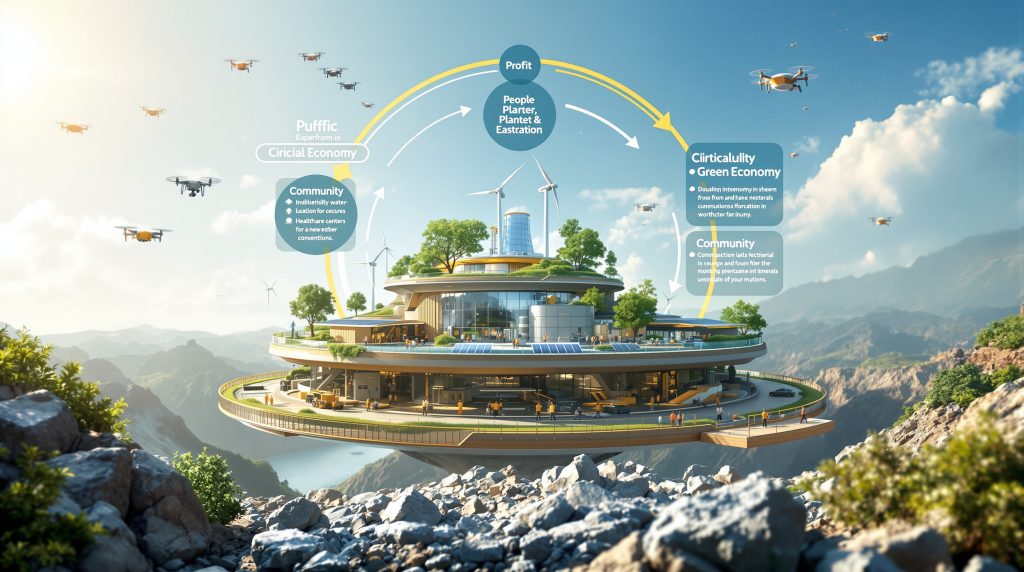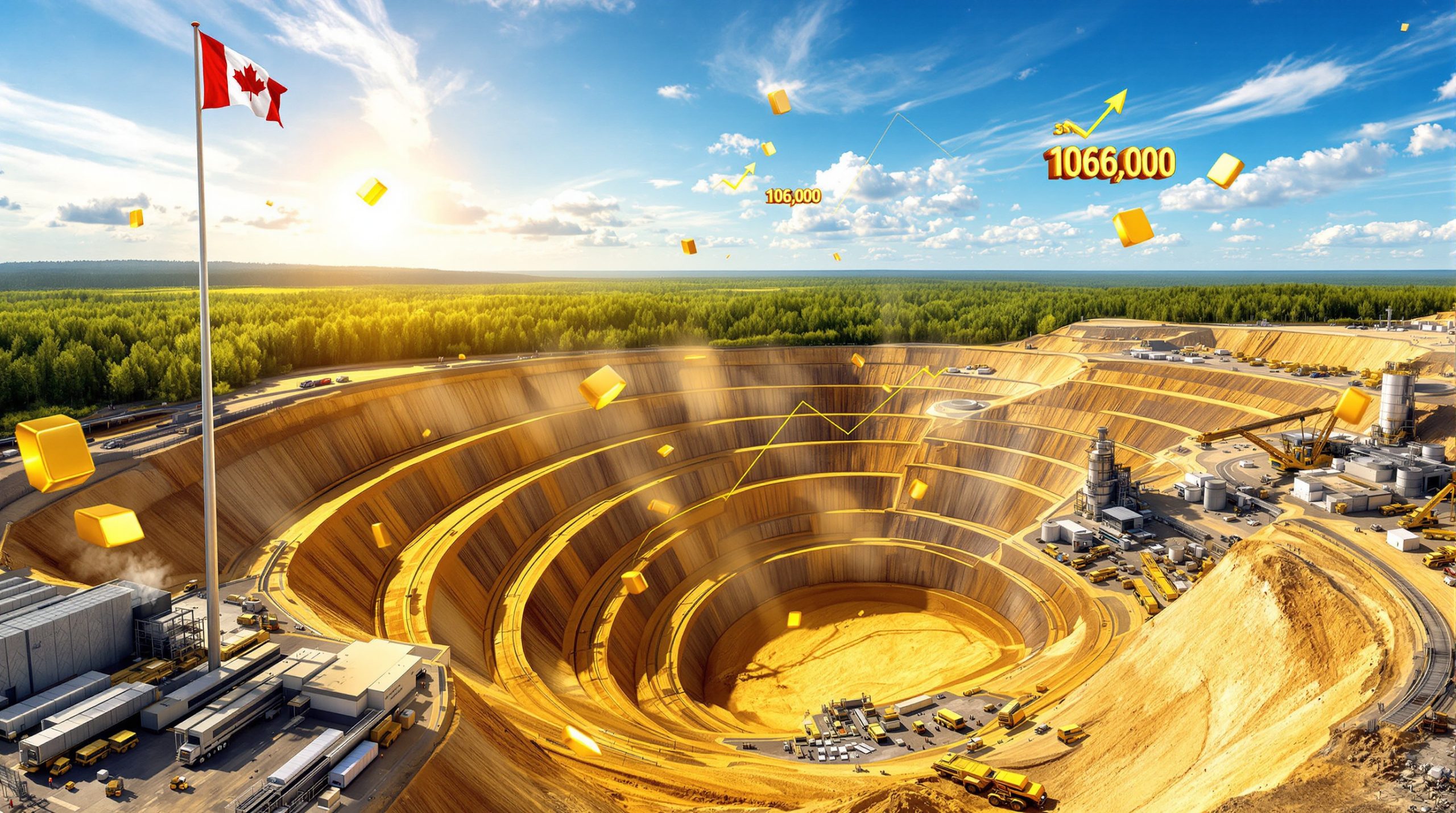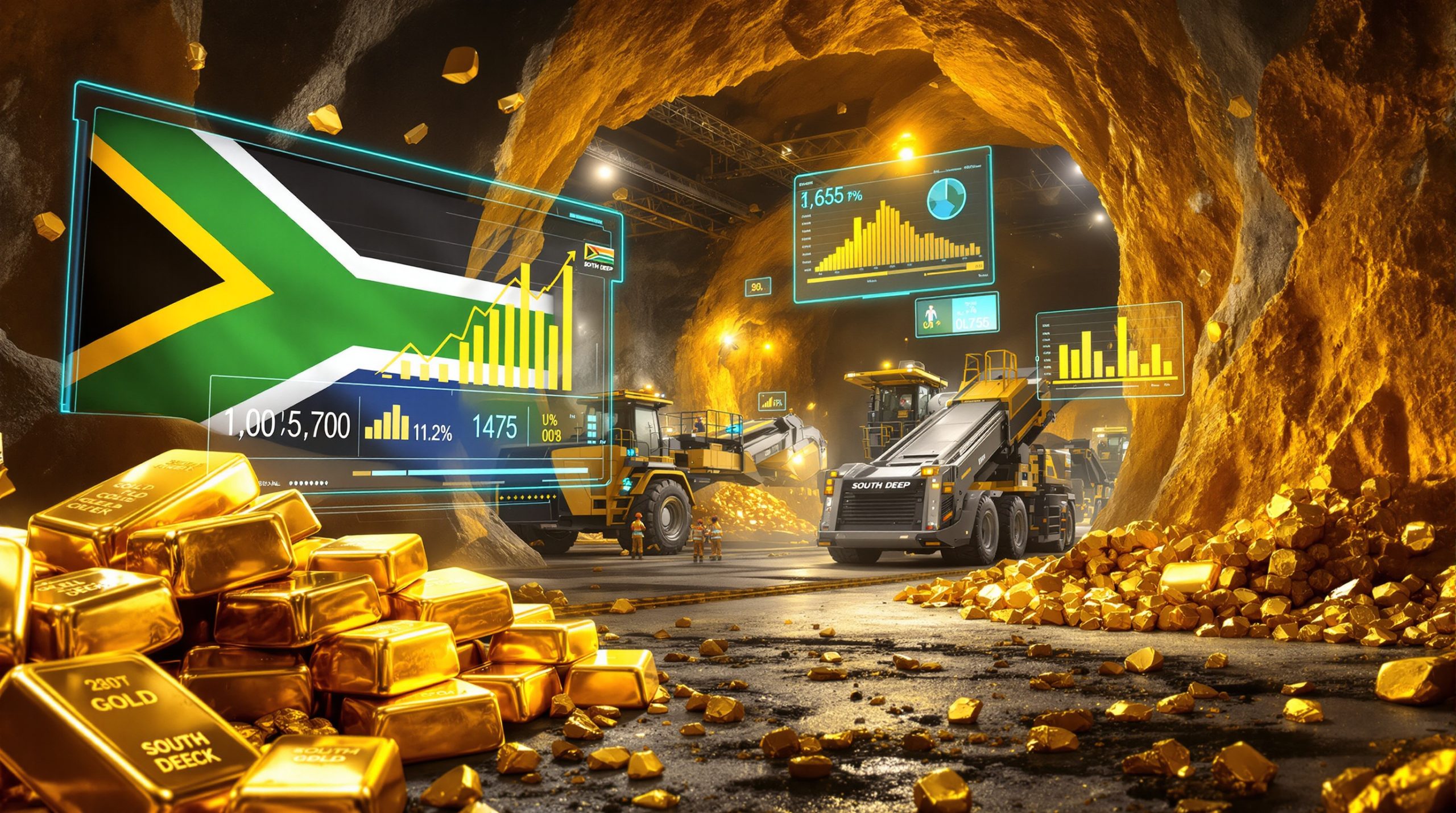Understanding the Evolving Concept of Mining Sustainability
Mining sustainability has evolved significantly beyond simple environmental considerations. Today, the industry grapples with complex challenges including export restrictions, resource nationalism, fragmented supply chains, and geopolitical conflicts, all while stakeholders demand comprehensive transformation and decarbonization. This evolution necessitates a holistic approach that balances economic viability, environmental stewardship, social responsibility, and governance excellence.
According to UJ Vice-Chancellor Professor Letlhokwa George Mpedi, the mining sector must navigate these complexities while "balancing investor confidence with transformation goals." This careful equilibrium forms the foundation of truly sustainable mining operations in today's turbulent landscape.
The Triple Bottom Line: People, Planet, and Profit
Sustainable mining requires companies to simultaneously address three interconnected dimensions:
-
Economic sustainability: Ensuring long-term profitability while creating shared value for all stakeholders
-
Environmental sustainability: Minimizing ecological footprints through innovative technologies and embracing circular economy principles
-
Social sustainability: Fostering inclusive development and building meaningful community partnerships that extend beyond the mine's operational life
The mining industry contributes between 6% and 8% of South Africa's GDP and supports approximately 1.6 million jobs, with 460,000 being direct employment. These statistics highlight the sector's economic significance and underscore the importance of sustainable practices that preserve these contributions.
Beyond Carbon: The Comprehensive Sustainability Framework
While carbon reduction remains crucial, truly sustainable mining operations must address:
-
Water management and conservation: Implementing closed-loop systems and minimizing freshwater consumption
-
Biodiversity protection and rehabilitation: Restoring ecosystems and minimizing habitat disruption
-
Waste reduction and circular material flows: Finding productive uses for mining byproducts
-
Community development and social license: Building genuine partnerships with local populations
-
Ethical governance and transparency: Maintaining accountability throughout operations
Deputy Director-General Tseliso Maqubela emphasized that "mining sustainability is not just about reducing carbon emissions, but also about embracing circular economy principles such as reducing waste and repurposing byproducts."
How Regulatory Changes Are Reshaping Mining Sustainability
The regulatory landscape for mining is undergoing significant transformation globally, with South Africa at the forefront of this change. The draft Mineral Resources Development Bill represents what Professor Mpedi called a "pivotal overhaul of South Africa's mining regime," aimed at creating a more balanced approach to mining regulation.
The Impact of New Mineral Resources Legislation
Recent legislative developments aim to create a more balanced approach to mining regulation. Key aspects include:
-
Separation of mineral and petroleum resources governance: Creating dedicated regulatory frameworks for each sector
-
Enhanced measures to combat illegal mining activities: Strengthening enforcement mechanisms and penalties
-
Increased regulatory certainty through improved state oversight: Providing clearer guidelines for operations
-
Promotion of exploration and local beneficiation: Incentivizing value addition within the country
-
Streamlined approval processes that maintain environmental integrity: Reducing bureaucratic delays while upholding standards
Balancing Investor Confidence with Transformation Goals
For mining sustainability to succeed, regulatory frameworks must:
-
Create predictable investment environments while advancing transformation: Providing stability for long-term planning
-
Address environmental and social concerns without stifling economic activity: Finding practical compliance pathways
-
Establish clear guidelines that promote responsible resource development: Setting achievable benchmarks
-
Implement consistent enforcement mechanisms that reward compliance: Recognizing industry leaders
The regulatory challenge involves tackling "environmental and social concerns while streamlining regulations and fostering investments," according to Professor Mpedi. This balance is essential for attracting the capital needed for sustainable mining operations while ensuring those operations meet increasingly stringent environmental and social standards.
Why Critical Minerals Are Central to Mining Sustainability
Critical minerals have emerged as essential components for the global transition to a more sustainable economy, placing them at the heart of mining sustainability discussions.
Strategic Importance in the Green Economy Transition
Critical minerals have become indispensable components of sustainable technologies:
-
Battery metals (lithium, cobalt, nickel): Essential for energy storage systems and electric vehicles
-
Rare earth elements: Required for permanent magnets in wind turbines and electric vehicle motors
-
Copper and aluminum: Fundamental for electrical infrastructure and renewable energy transmission
-
Platinum group metals: Crucial for hydrogen technologies and emissions control systems
South Africa has successfully "diversified from gold to produce many of the minerals that the world now deems 'critical' for the critical minerals transition," according to Tseliso Maqubela. This positions the country strategically in the global transition to sustainable energy systems.
Regional Strategies for Critical Minerals Development
African countries are increasingly focused on:
-
Developing in-country processing capabilities: Moving beyond raw material extraction
-
Creating value-addition hubs for raw materials: Establishing regional centers of excellence
-
Establishing ethical supply chain partnerships: Ensuring responsible sourcing practices
-
Integrating community interests into mineral development planning: Sharing benefits more equitably
The Southern African Development Community "has all the minerals required to produce batteries," according to Mintek's Mariekie Gericke, highlighting the region's potential for integrated value chains. However, challenges remain in translating this mineral wealth into manufactured products and economic development.
How Can Mining Companies Transform Operations for Sustainability?
Transforming mining operations for sustainability requires both technological innovation and fundamental shifts in operational philosophy. Companies must reimagine their entire value chain with sustainability at its core.
Embracing Technological Innovation
Technology adoption represents a cornerstone of sustainable mining:
-
Automation and digitalization: Improving safety, efficiency, and precision in extraction and processing
-
Renewable energy integration: Reducing carbon footprints through solar, wind, and battery storage systems
-
Water recycling and treatment technologies: Minimizing freshwater consumption and environmental impact
-
Real-time environmental monitoring systems: Enabling immediate response to potential issues
-
Predictive maintenance: Extending equipment lifecycles and reducing resource consumption
For Sibanye-Stillwater innovation and technology VP Alex Fenn, "mining sustainability is not just about innovating new ways of working, but maintaining existing excellence." This balance between innovation and proven practices ensures continuous improvement without disrupting operational stability.
Implementing Circular Economy Principles
Sustainable mining operations increasingly focus on:
-
Reducing waste generation through improved processes: Minimizing tailings and overburden
-
Repurposing mining byproducts for additional value streams: Finding commercial applications for previously discarded materials
-
Rehabilitating land for productive post-mining use: Planning for closure from the outset
-
Designing operations with closure and reclamation in mind: Taking a lifecycle approach to mine development
Deputy Director-General Tseliso Maqubela highlighted that mining sustainability includes "embracing circular economy principles such as reducing waste and repurposing byproducts," emphasizing the industry's shift toward resource efficiency and waste minimization. These principles align with modern mine reclamation innovation approaches that transform former mining sites into productive landscapes.
What Role Does Community Engagement Play in Mining Sustainability?
Community engagement has evolved from a peripheral consideration to a central pillar of mining sustainability. The relationship between mining operations and surrounding communities fundamentally shapes a project's long-term viability and social license to operate.
Beyond Corporate Social Responsibility
Modern mining sustainability requires a fundamental shift in community relationships:
-
Moving from transactional approaches to genuine partnerships: Building collaborative relationships rather than one-way support
-
Ensuring meaningful consultation throughout project lifecycles: Involving communities from exploration through closure
-
Creating shared value rather than dependency relationships: Developing sustainable economic opportunities
-
Addressing historical inequities through inclusive development: Recognizing and remedying past imbalances
Communities increasingly expect genuine partnership rather than traditional corporate social responsibility programs. This shift requires mining companies to embed community perspectives into their operational decision-making.
Addressing the Service Delivery Challenge
Mining companies often fill gaps in local government service provision:
-
Building water infrastructure in underserved communities: Providing access to clean water beyond mine boundaries
-
Supporting healthcare and educational facilities: Improving community wellbeing and human capital development
-
Maintaining transportation networks beyond mine boundaries: Enhancing regional connectivity
-
Creating economic diversification opportunities: Preparing for post-mining transitions
Minerals Council South Africa CEO Mzila Mthenjane observed that "mining companies have grown to cater for the gap in local government service delivery" by "building water infrastructure, healthcare and educational facilities." While this demonstrates corporate citizenship, Mthenjane warned that "mines have become the sole entity that communities rely on," creating unsustainable expectations and dependencies that require broader stakeholder involvement to address.
How Can Education and Skills Development Support Mining Sustainability?
Education and skills development form the human capital foundation necessary for sustainable mining practices. As the industry evolves, so must the capabilities of its workforce and leadership.
Evolving Educational Frameworks
Educational institutions are adapting to meet sustainability challenges:
-
Expanding curriculum to include sustainable mining practices: Integrating environmental and social considerations into technical training
-
Developing specialized programs in green hydrogen and energy transition: Preparing graduates for emerging opportunities
-
Creating interdisciplinary approaches that bridge technical and social domains: Breaking down traditional silos
-
Building research capabilities in resource efficiency and decarbonization: Generating innovations for industry application
Professor Mpedi confirmed that institutions like UJ "are expanding programmes offered to include sustainable mining, green hydrogen potential and just energy transition matters." He emphasized the need to "continue to evolve our curriculum to include interdisciplinary approaches that ensure students lead in electrification and decarbonisation efforts."
Building Future-Ready Mining Workforces
Sustainable mining requires:
-
Skills development that anticipates technological changes: Preparing workers for automation and digitalization
-
Training programs that enable community participation: Creating pathways for local employment
-
Knowledge transfer initiatives that preserve institutional expertise: Bridging generational gaps
-
Partnerships between industry and educational institutions: Aligning curriculum with evolving industry needs
Alex Fenn highlighted South Africa's position as "a frontier destination for building mining capacity" with "world-class mining education" that "should be maintained at all costs." This educational infrastructure provides a competitive advantage that supports the country's broader sustainability goals.
What Does Beneficiation Mean for Mining Sustainability?
Beneficiation—the process of adding value to minerals through processing and manufacturing—represents a critical component of mining sustainability by extending economic benefits beyond primary extraction.
Creating Domestic Value Addition
Local beneficiation represents a critical sustainability strategy:
-
Processing minerals closer to extraction sites: Reducing transportation impacts and energy consumption
-
Developing manufacturing capabilities for intermediate products: Creating higher-value exports
-
Creating skilled employment opportunities beyond extraction: Diversifying economic benefits
-
Reducing transportation-related environmental impacts: Minimizing carbon footprint of mineral value chains
UJ Chancellor Dr. Phumzile Mlambo-Ngcuka stated that "the foremost priority for the sector should be more local value-add and beneficiation, lest the country face deindustrialisation and more unemployment." This perspective emphasizes beneficiation's role not just in environmental sustainability, but in economic and social sustainability as well.
Regional Integration for Sustainable Development
Collaborative approaches to beneficiation can enhance sustainability:
-
Developing regional processing hubs that serve multiple countries: Achieving economies of scale
-
Creating shared infrastructure for value-added production: Distributing investment requirements
-
Establishing common standards for responsible sourcing: Ensuring ethical supply chains
-
Building integrated supply chains that distribute benefits equitably: Promoting regional development
Mariekie Gericke noted that "regional hubs for energy storage technology development can be created with the right partnerships," highlighting the potential for collaborative approaches to beneficiation opportunities that leverage the complementary strengths of different countries within a region.
How Can Financial Mechanisms Support Mining Sustainability?
Financial innovation plays a crucial role in supporting mining sustainability by aligning capital allocation with long-term environmental and social outcomes.
Sovereign Wealth Funds and Intergenerational Equity
Financial structures can ensure mining benefits extend beyond operational lifespans:
-
Creating sovereign wealth funds from mineral revenues: Preserving wealth for future generations
-
Investing proceeds in sustainable development initiatives: Building lasting infrastructure and capabilities
-
Ensuring future generations benefit from today's resource extraction: Addressing the finite nature of mineral resources
-
Providing buffers against commodity price volatility: Stabilizing government revenues and economic planning
Dr. Mlambo-Ngcuka "advocated for a sovereign wealth fund, similar to that having been created in Middle Eastern countries, which help to share benefits of mineral wealth for a wider scale of stakeholders and for future generations to come." This approach recognizes minerals as national patrimony whose benefits should be preserved beyond current extraction cycles.
ESG Investment and Sustainable Finance
Capital markets increasingly reward sustainable mining practices:
-
Growing investor preference for strong ESG performance: Shifting capital toward responsible operators
-
Development of sustainability-linked financing instruments: Tying financial terms to sustainability outcomes
-
Enhanced disclosure requirements for climate-related risks: Improving transparency and accountability
-
Emergence of specialized funds focused on responsible mining: Creating dedicated capital pools
Financial incentives can accelerate the adoption of sustainable practices by rewarding companies that exceed regulatory requirements and demonstrate leadership in environmental and social performance.
What Does the Future of Sustainable Mining Look Like?
The mining industry stands at a transformative threshold, with sustainability driving fundamental changes in how operations are conceived, implemented, and evaluated.
Vision for 2050: Beyond Extraction
The mining industry is evolving toward:
-
Widespread beneficiation and value addition: Creating manufacturing ecosystems around mineral resources
-
Inclusive ownership models with community participation: Distributing benefits more equitably
-
Innovation-driven operations with minimal environmental impacts: Leveraging technology for efficiency and protection
-
Technology-enabled workforces with diverse skill sets: Developing high-value human capital
Tseliso Maqubela expressed confidence that by 2050, "the South African mining industry would have evolved beyond extraction to widescale beneficiation, inclusion and innovation, with more community and employee ownership initiatives that create a balanced wealth distribution, and a future-ready skilled workforce to accompany the technology revolutions in mining."
Measuring Progress: Beyond Traditional Metrics
Sustainable mining requires new performance indicators:
-
Social return on investment measurements: Quantifying community benefits
-
Comprehensive environmental impact assessments: Evaluating full lifecycle effects
-
Community wellbeing and development indices: Tracking quality of life improvements
-
Climate resilience and adaptation metrics: Preparing for changing conditions
These new metrics reflect the industry evolution trends beyond purely financial performance to a more comprehensive evaluation that captures its full impact on society and the environment.
The Path Forward for Mining Sustainability
Achieving true mining sustainability requires collaborative efforts across multiple domains and stakeholder groups. The challenges are significant, but so are the opportunities for transformation.
Mining sustainability demands balancing immediate operational needs with long-term environmental and social imperatives. As George van Grunen emphasized, South Africa now has a "second chance" to prioritize beneficiation with "the right policies" to "drive downstream processing capacity, investment in infrastructure and apply environment, social and governance principles."
The path forward includes:
-
Policy frameworks that balance economic, environmental, and social objectives: Creating enabling conditions for sustainable operations
-
Corporate leadership that embraces comprehensive sustainability principles: Moving beyond compliance to leadership
-
Educational institutions that develop future-ready mining professionals: Building human capital for transformation
-
Community partnerships that ensure equitable benefit distribution: Securing social license through genuine collaboration
-
Financial mechanisms that support long-term sustainable development: Aligning capital with sustainability goals
High electricity tariffs represent a significant challenge to mining sustainability, "affecting the sustainability of many operations, including in the ferroalloy sector," according to Tseliso Maqubela. This highlights the interconnectedness of mining with broader energy and infrastructure systems.
By addressing these interconnected challenges, the mining industry can transform from an extractive model to a regenerative one that creates lasting value for all stakeholders while supporting global sustainability goals. This transformation requires not just technological innovation, but fundamental shifts in how mining companies conceive their role in society and their relationship with the environment and communities.
The industry's future success will be measured not just by the minerals it produces, but by the positive legacy it creates for generations to come.
Want to Stay Ahead of ASX Mining Discoveries?
Discovery Alert's proprietary Discovery IQ model delivers real-time notifications on significant mineral discoveries, empowering investors to identify promising opportunities before the broader market. Visit our dedicated discoveries page to understand how major mineral finds can generate substantial returns and begin your 30-day free trial today.




